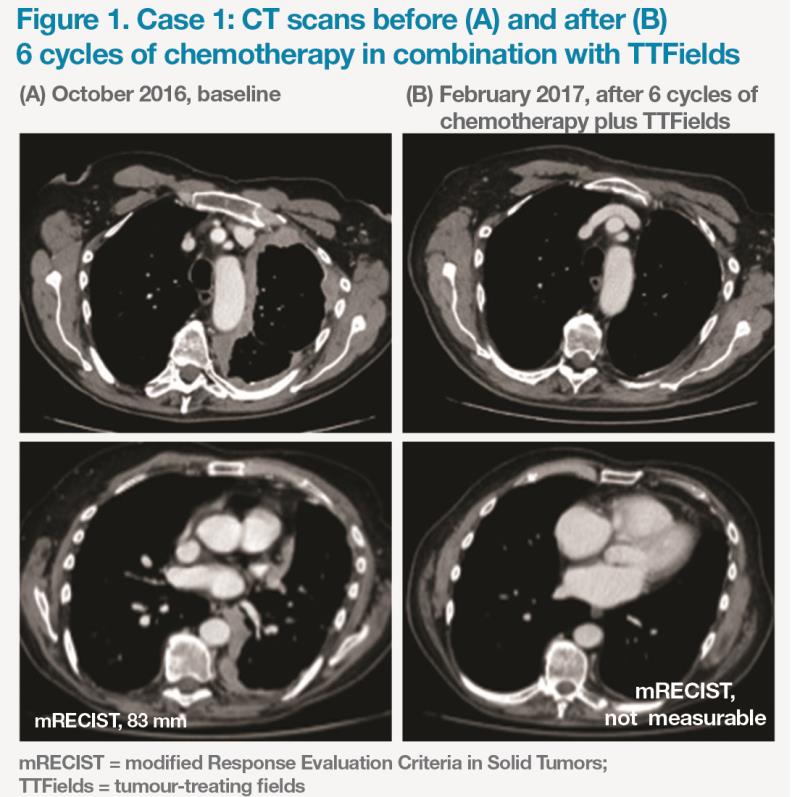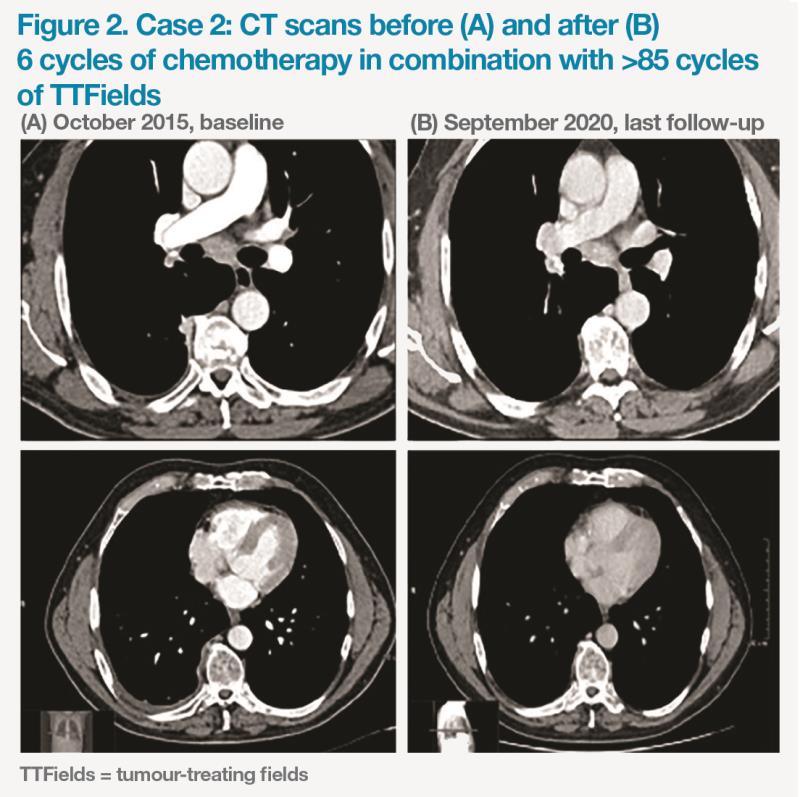Tumour-treating fields: A novel treatment modality for malignant pleural mesothelioma





Malignant pleural mesothelioma (MPM) is a rare, aggressive form of cancer with limited treatment options. At the 7th Hong Kong International Oncology Symposium, Professor Giovanni Luca Ceresoli of the Cliniche Humanitas Gavazzeni in Bergamo, Italy, presented data and shared two patient cases on tumour-treating fields (TTFields) – a novel treatment modality and the first new treatment to be approved for MPM by the US FDA in more than 15 years.
“MPM is a rare cancer with a poor prognosis, where the majority of patients are not candidates for surgical resection. Its complex biology, tumour heterogeneity and lack of driver mutations have made treatment challenging. Anti-angiogenic agents failed to show outcome improvements and had the drawback of increased toxicity. Thus, systemic chemotherapy with platinum/pemetrexed has remained the standard of care for MPM for the last 15 years. However, median overall survival [OS] with chemotherapy is about 12 months only, highlighting a considerable need for new treatment options,” said Ceresoli. [J Clin Oncol 2018;36:1343-1373]
“Immunotherapy has shown activity against MPM, but the efficacy results were inconclusive due to the highly immunosuppressive microenvironment. Recently, a dual immunotherapy regimen has demonstrated survival benefits over chemotherapy alone mainly in patients with non-epithelioid histology, but was associated with increased toxicity,” pointed out Ceresoli. [Transl Lung Cancer Res 2020;9(Suppl 1):S100-S119]
TTFields: A noninvasive antimitotic therapy
TTFields are low-intensity (1–3 V/cm), intermediate-frequency (100–300 kHz), alternating electric fields generated by transducer arrays that are applied to the thorax of MPM patients and are connected to a portable battery-operated device. [Sci Rep 2015;5:18046; Annu Int Conf IEEE Eng Med Biol Soc 2015;2015:6888-6891]
TTFields disrupt tubulin subunits and mitotic spindle formation, leading to metaphase arrest, prolonged mitosis and ultimately cell death in dividing cancer cells. [Clin Cancer Res 2018;24:266-275] They can be frequency-tuned according to cancer cell histology and have been shown to inhibit mesothelioma cells in vitro at 150 kHz. [NovoTTF-100L System Instruction Manual]
Efficacy and safety of TTFields
The STELLAR trial was a phase II, prospective, single-arm registration trial of TTFields used in combination with chemotherapy in first-line treatment of MPM. Patients (n=80) received continuous TTFields for ≥18 hours daily with concomitant pemetrexed and cisplatin or carboplatin for up to six cycles, followed by TTFields as maintenance treatment until disease progression. [Lancet Oncol 2019;20:1702-1709]
After a median follow-up of 12.5 months, median OS was 18.2 months. “The STELLAR results were encouraging as TTFields plus chemotherapy demonstrated an improvement in median OS compared with historical control data of 12 months with chemotherapy alone. Among 72 patients evaluated for radiological response, disease control rate at first CT scan evaluation was very high, at 97 percent, with 40 percent of patients achieving partial response [PR] and 57 percent attaining stable disease,” Ceresoli remarked.
“TTFields therapy was well tolerated. The only adverse event [AE] related to TTFields was skin toxicity [localized dermatitis beneath the transducer arrays], which was reported by 71 percent of patients. Most of these events were mild to moderate in intensity [66 percent]; only four patients [5 percent] had severe [grade ≥3] events, and none of them were reported as serious AEs. Most of the events could be managed with topical corticosteroids or a short treatment break in more severe cases,” noted Ceresoli.
Importance of treatment compliance
In a subgroup analysis of a phase III randomized clinical trial that compared TTFields plus chemotherapy vs chemotherapy alone in patients with glioblastoma, increased compliance with TTFields was found to be an independent prognostic factor for improved survival outcomes. [J Neurooncol 2019;141:467-473]
In STELLAR, the median compliance with TTFields in the first 3 months was 16.3 hours/day. “Patients’ compliance can be improved by proactively avoiding excessive skin irritation, namely, removing the arrays at least every 3–4 days; removing arrays slowly and carefully with the use of mineral oil on the edge to minimize skin damage; shifting the arrays 1–2 cm from the previous position at each change; and reapplying the arrays only when the skin is completely dry. It is crucial for patients to report the earliest signs of dermatitis so that it can be treated promptly to avoid prolonged treatment interruption,” Ceresoli noted.
Patient cases from the STELLAR trial
Case 1
A 70-year-old male patient with epithelioid MPM was commenced on TTFields plus carboplatin/pemetrexed in October 2016. After six cycles of combination therapy, the tumour was non-measurable. (Figure 1) Treatment was well tolerated, with chemotherapy-related grade 3 anaemia as the only reported AE. The patient continued TTFields as maintenance treatment for four more cycles until developing grade 2 skin toxicity.
The patient’s outcome has been favourable, with a PR (near-complete response) and no disease progression for 10 months. Currently, the patient is receiving second-line treatment for MPM. His OS is 48 months as of November 2020.

Case 2
A 63-year-old male patient with biphasic MPM was commenced on six cycles of TTFields plus carboplatin/pemetrexed in October 2015, followed by TTFields maintenance. He experienced mild, chemotherapy-related hepatotoxicity, mucositis and a hypersensitivity reaction to carboplatin (all grade 1), with no skin toxicity reported, in spite of high compliance with TTFields (median ≥18 hours/day) The patient had a PR (near-complete response), with no disease progression for >60 months as of November 2020. (Figure 2) Currently, the patient is in good clinical condition and remains on maintenance therapy with TTFields.

Conclusion
TTFields used in combination with pemetrexed and platinum-based chemotherapy, and as maintenance treatment thereafter, has demonstrated promising activity in unresectable MPM, with no increased systemic toxicity. This regimen represents a novel approach to treating this rare and aggressive form of cancer.